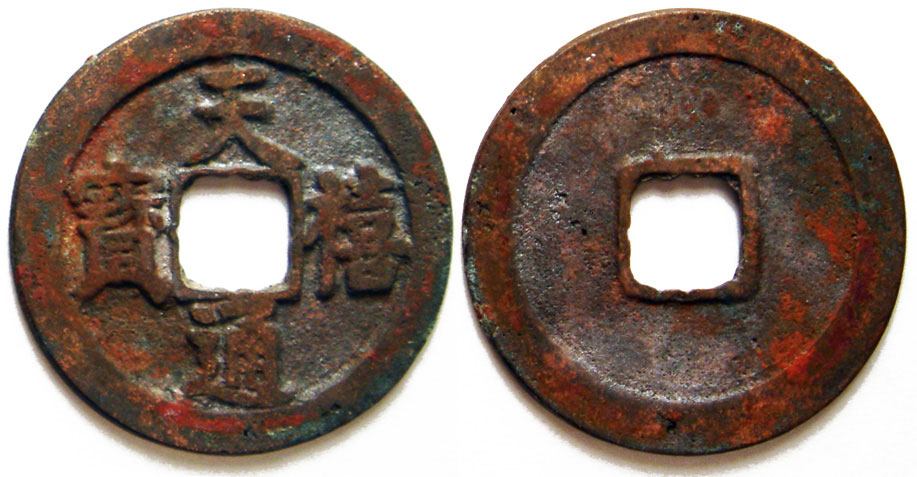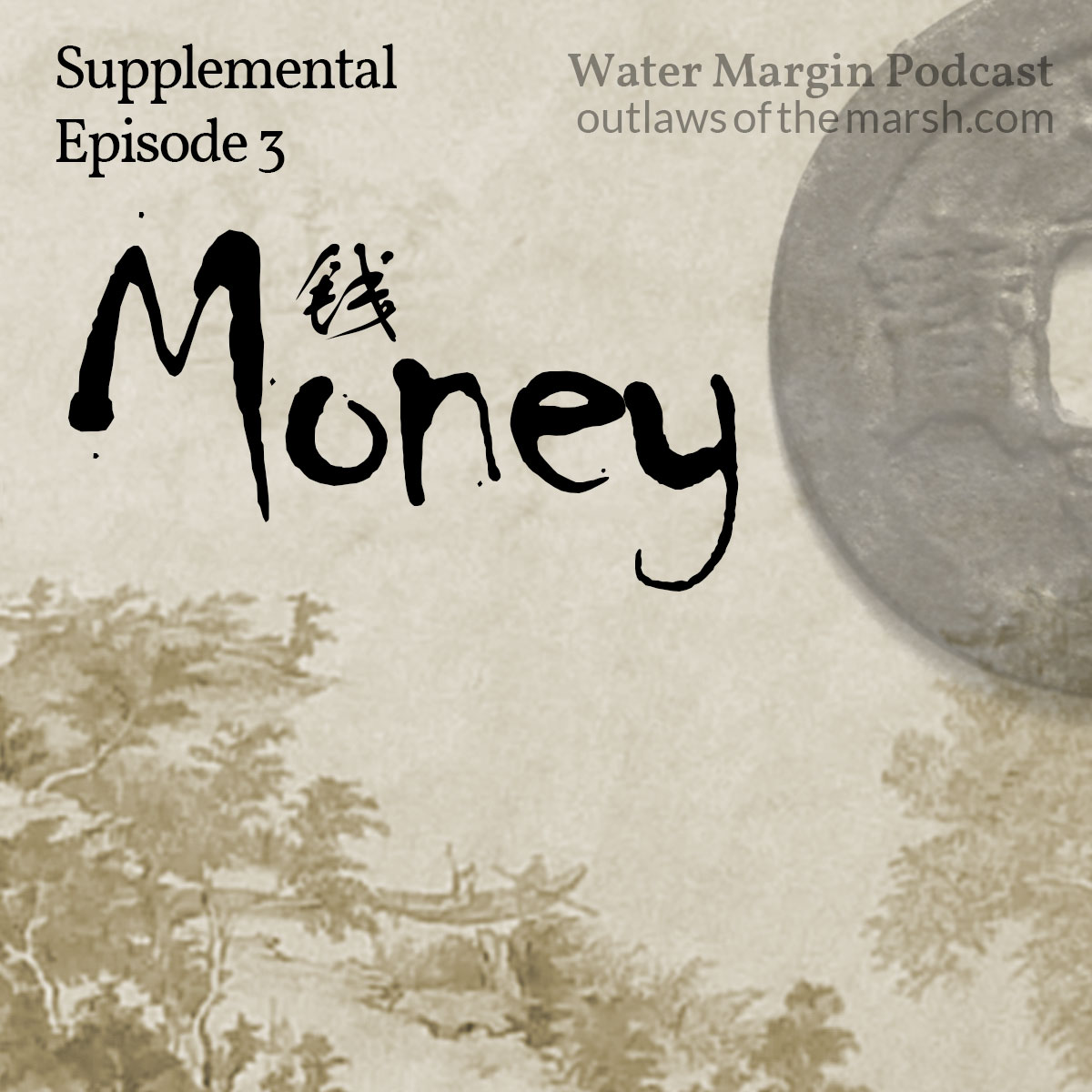A quick look at currencies, income, and living expenses during the Northern Song.
Transcript
Welcome to the Water Margin Podcast. This is a supplemental episode.
In this episode, I’m going to take a quick look at money and currency during the Northern Song. We have had plenty of mentions about money matters in the novel so far, what with a bribes-based judicial system and all. You’ve heard me mention units of currency like strings of coins or taels of silver, so I figure it would be helpful to provide a little more context into the financial system of the time period.
Let’s start with the lowest unit of currency: 1 coin, which was called a wen (2). Round coins have been used in China since at least the 350s B.C By the time of the Northern Song, the most common coins were made from copper. According to historical records, in the year 1019, the composition of the copper coins were set at 64 percent copper, 27 percent lead, and 9 percent tin. But there were also large numbers of coins of other materials floating around, such as iron or lead. For instance, early on in the dynasty, there were substantial numbers of iron coins minted in the southwestern region of Sichuan, where iron ore was plentiful.
Let’s talk a little bit about the design of the coins. Like earlier coins in Chinese history, the Northern Song coins had a square hole in the center, so that you could run a string through them. In the novel, you’ve heard me talk about quantities of money in terms of strings of coins. One of those strings is supposedly made up of 1,000 coins, but as we will discuss shortly, that number was definitely not set in stone.

The faces of the coins carried inscriptions, many of which were written by the ruling emperor at the time of minting. The fact that these coins carried the calligraphy of emperors makes them a neat piece of imperial history and great artifacts for historical study. It also meant the design of the coins would change when a new emperor took over. The inscriptions also changed when an emperor declared the start of a new period in his reign, and an emperor would typically do this multiple times in his tenure. So add it all up, and you are looking at a wide array of coins with different designs being in circulation at any one time.
To give you an idea of how many coins were in circulation, over an eight-year span from 1078 to 1085, more than 5 million strings of copper coins were minted per year. Assuming there were 1,000 coins per string, that comes out to 40 billion coins over those eight years.
Now, in the novel, in addition to coins, we also see silver being used as another common type of currency. For instance, in episode 13, Lin Chong bought a sword for 1,000 strings. Again, assuming there were 1,000 coins to a string, that would be the equivalent of a million coins. But as I said in that episode, he didn’t actually pay up with a million coins, since that’d be ridiculous. Instead, he paid the equivalent of that amount in silver.
And that, of course, begs the next logical question: What’s the coin-to-silver exchange rate? Well, that’s apparently a bit of a mess, in part because there were so many different types of coins and because their values varied across regions. For instance, in some areas, 10 iron coins were considered equivalent to 1 copper coin, but that would be different in other areas. And remember how I said earlier that one string supposedly consisted of 1,000 copper coins? Well, actually that fluctuated wildly, too. Some places apparently had just 800 coins to a string, and some had fewer than 500. Given such inconsistencies, it’s no surprise that we don’t have a super accurate idea of what the copper coins-to-silver exchange rate was. In other dynasties, that rate was generally 1,000 coins, or 1 string, being equal to 1 tael of silver, with a tael being one-and-a-third ounces. But during the Song Dynasty, because of inflation and a relative scarcity of silver, one tael of silver might’ve been worth more than 2,000 coins.
So far we’ve just been discussing the value of these currencies in terms of other currencies, like how many iron coins equal to one copper coin and how many copper coins equal to one tael of silver. None of that, of course, means anything without some idea of people’s income and expenditures. Here’s what I’ve been able to find on that.
For income, let’s start with the highest court officials. According to the information I found, the top ministers received 300 strings of coins in salary per month. In addition, these officials also received set amounts of various linens and fabrics, as well as a monthly supply of grain, as much as 15,000 pounds per month. So that works out to something like 3,600 taels of silver in salary and 180,000 pounds of grain per year.
That compensation, of course, decreased as you went down the ranks of court officials, and on the list I found, the lowest court official listed was raking in a mere 7 strings of coins per month, which comes out to 84 strings a year, and these lowest officials didn’t get any fabric or grain in addition to their salary.
On the other end of the spectrum, let’s look at the commoners. There are various fragmentary pieces of information offering insight into what the average civilian might have made. For instance, one source states that a fisherman living in a southwestern prefecture during the late Northern Song earned no more than 100 iron coins a day. Another record, dating from the middle of the Northern Song Dynasty, said that someone doing various odd jobs could piece together 100 coins a day. Another source recounted the story of a woman from Cangzhou Prefecture — yes, the same Cangzhou Prefecture that Lin Chong was exiled to. This woman, according to the source, made a few dozen coins a day selling fruits in town. So, let’s say the typical commoner made maybe 100 coins a day. Let’s say they worked 365 days a year, that would come out to more than 36,000 coins a year, or about 36 taels of silver. Some sources suggested they could make as much as 300 coins a day, so it was possible a common civilian could take in about 100 taels of silver in a year.
So that’s the income side of things. What about expenditures? What did stuff cost, and what’s the least amount of money you could live on? From what I could find, subsistence income seemed to be about 20 coins a day, including expenses for food. And one source said the poor could survive on 10 coins and 1 pint of rice per day. Another source recounted that in the year 1069, many destitute residents in the capital Kaifeng were dying because of a particularly harsh winter, to the point where the government handed out relief. And that relief was in the form of giving 20 coins a day to those who qualified. Yet another source stated that during the reign of the Huizong Emperor, aka the time period in which the Water Margin is set, a nursing home gave its residents 2 pints of rice and 20 coins each day.
In addition to these sources, I also found some lists of prices of common items. For instance, during the time of the Huizong Emperor, 100 pints of rice, or about 150 pounds, cost as much as 4 strings. A bolt of thick silk cost about a string. As for salt, one cattie, or 1.3 pounds, cost 50 to 70 coins, though it could go up to as high as 300 in certain locations. A cattie of tea leaves cost about 69 to 70 coins. A bushel of horse feed cost about 30 coins.
From what I could find, it seems that the typical commoner consumed about one-and-a-half pints of grain per day. So if we do the math, that means one person would consume just under 550 pints of grain a year, which, according to the prices I just mentioned, could cost more than 22 taels of silver. I mentioned earlier that the typical commoner maybe earned about 36 taels of silver a year. So you’re looking at more than 60 percent of your income going to grain alone.
So that’s food. What about housing? Interestingly, the information I found suggested that while purchasing a house was well beyond the means of most people, officials included, the cost of renting a house was not particularly burdensome. One source stated that in the year 1025, the capital Kaifeng collected a total of 134,629 strings of coins in rent for the year. Within the capital, there were more than 26,000 rental homes that year, so it averaged out to about 450 coins per month for rent. Remember that we said earlier a commoner could earn between 100 to 300 coins a day. So a family with two full-time wage earners could be taking in something like 6,000 coins a month, in which case housing would only cost something like 7 percent of their income. That seems like a pretty reasonable amount, certainly less of a burden than food. And remember, this is the capital we’re talking about, where one would imagine that real estate prices are inflated.
Finally, I want to touch on an interesting note. The Northern Song is credited as having used the first paper money in history. This started in the southwestern region of Sichuan, where iron coins were the common unit of currency. But iron coins were worth less and weighed more than copper coins, which made them extra unwieldy to carry around. So there were banks where people could store their iron coins for safekeeping, and the bank would issue them paper notes that they could then use in their day-to-day life.
These paper notes, which were called jiaozi (1,3), came in different amounts, ranging from 1 string of coins to 10. But since the lowest value was 1 string, or 1,000 coins, their usage was limited to larger transactions. The notes were printed with red and black ink and carried special numbers and images to prevent forgery. In 1023, the imperial government centralized the issuance of these paper notes. Instead of being locally printed, the notes were now issued by the central government, and they became the primary currency in the Sichuan region. The government also set an expiration date on each batch of notes, so the notes had to be either redeemed or replaced with newer notes before it expired. This expiration period started at 2 years but was later raised to 3.
The problem with this paper currency was that the government didn’t back it with enough coins, so inflation ran rampant. Despite efforts to address this, such as the Huizong emperor creating a new type of banknote, the value of the currency continued to plummet. And eventually, the government just threw up its hands and abolished the jiaozi as a form of currency, although it stayed in circulation until the mid 1200s.
Alright, that does it for this supplemental episode. I hope you enjoyed it, and I’ll see you next time on the Water Margin Podcast. Thanks for listening!

